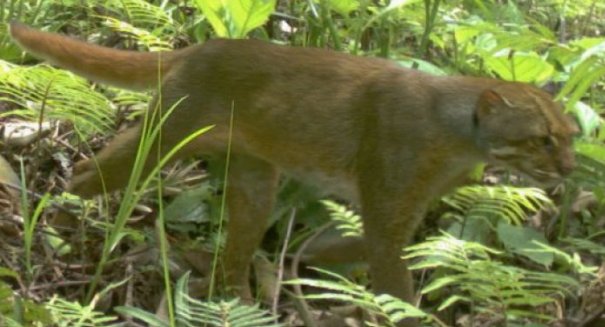
Camera traps have altered how data is collected for many species of mammals and birds.
Researchers from the Zoological Society of London have captured rare footage of the little-known bay cat. Pardofelis badia, also known as the bay cat, had been previously captured on camera traps just several times in the forests of Borneo. In fact, it wasn’t until 2003 that the bay cat was first imaged in the wild.
According to researchers, more photos of Pardofelis badia have been snapped than ever before, along with evidence of four other wild cat species, in a heavily-logged region of forest where experts expected that they would not do well.
The IUCN Red List of Threatened Species notes that the bay cat appears to be forest dependent. Unfortunately, habitat loss because of commercial logging and oil palm plantations is threatening Borneo’s population of Pardofelis badia. Forest cover on Borneo, if current deforestation rates continue, is projected to decrease from 50 percent to less than one-third by 2020.
The area of forest where the images were taken is only one of four forest areas in all Borneo which has so far been confirmed to have all five species: Sunda clouded leopard, leopard cat, flat-headed cat and marbled cat.
“We discovered that randomly placed cameras have a big influence on the species recorded,” posited Oliver Wearn, a researcher at ZSL and Imperial College London, in a statement. “This is something I was taught in school – I remember doing a project on which plant species were most abundant on our playing field, and being taught to fling quadrats over my shoulder in a random direction before seeing what plants lay within it, rather than placing it somewhere that looked like a good place to put it – the same principle applies here.”
According to the researchers, camera traps have altered how data is collected for many species of mammals and birds. They offer an advantage to researchers who may be trying to track species that are good at avoiding detection. The World Wildlife Fund notes that camera traps are simply everyday cameras, outfitted with infrared sensors that snap a photo whenever they detect movement in the forest. However, moving and relocating the cameras takes time, because they are often left in remote locations.
“The cameras record multiple sightings, sometimes of species which we might be very lucky to see even after spending years in an area,” Wearn said. “For example, I’ve seen the clouded leopard just twice in three years of fieldwork, whilst my cameras recorded 14 video sequences of this enigmatic cat in just eight months.”
The researchers were taken aback to discover so many bay cats in Borneo at heavily-logged sites in the forest.
“Our study today shows solid evidence that even large carnivores, such as these magnificent bay cats, can survive in commercially logged forests,” noted Robert Ewers from the Department of Life Sciences at Imperial College London.
Leave a Reply